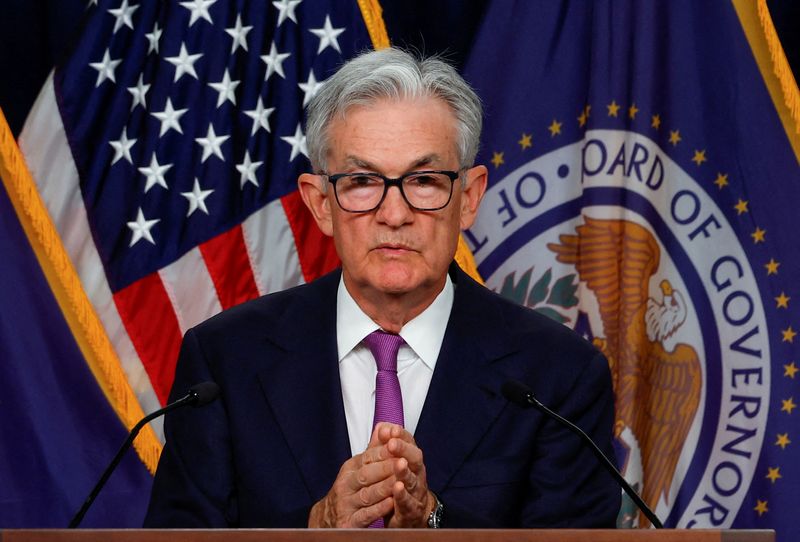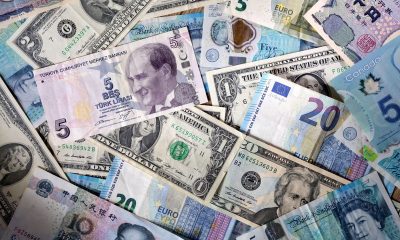Economy
Timeline of the Fed’s ethics controversy at the two-year mark


© Reuters. FILE PHOTO: U.S. Federal Reserve Chairman Jerome Powell holds a press conference after the release of the Fed policy decision to leave interest rates unchanged, at the Federal Reserve in Washington, U.S, September 20, 2023. REUTERS/Evelyn Hockstein/File P
By Michael S. Derby
NEW YORK (Reuters) – Federal Reserve Chair Jerome Powell two years ago asked the U.S. central bank’s internal watchdog to investigate the trading activities of some of its senior officials, including Powell. The probe has yet to conclude. Here’s a rundown of key events in the controversy.
Sept. 7, 2021: The Wall Street Journal reports that the presidents of the Dallas and Boston Fed banks actively traded in financial markets while helping set monetary policy. Fed ethics officials signed off on the trading, which was done most actively by Dallas Fed President Robert Kaplan, based on an ethics code then in place which called on policymakers to avoid investments that would suggest conflicts of interest.
Sept. 9, 2021: Kaplan and Boston Fed President Eric Rosengren pledge to divest their stock holdings.
Sept. 16, 2021: The Fed says it will review its existing ethics code. Democratic U.S. Senator Elizabeth Warren calls on the Fed to ban stock ownership by its leaders.
Sept. 22, 2021: Powell declines to offer support to Kaplan and Rosengren during a press conference following the end of a policy meeting. “I think no one is happy, no one on the FOMC (Federal Open Market Committee) is happy to be in this situation, to be having these questions raised,” he says.
Sept. 27, 2021: Kaplan and Rosengren announce their departures from the Fed within hours of one another.
Oct. 4, 2021: Powell refers the matter to Fed Inspector General Mark Bialek for a fuller investigation.
Oct. 8, 2021: The Dallas and Boston Fed banks pledge full cooperation with the IG probe, although a full accounting of Kaplan’s trading has never been made public.
Oct. 21, 2021: The Fed announces a new ethics code for central bank officials and senior staff that sharply restricts what they can invest in and when they can trade.
Jan. 6, 2022: The New York Times reports then-Fed Vice Chair Richard Clarida failed to report the extent of a trade in 2020 that was done as the Fed was preparing to offer emergency support during the onset of the coronavirus pandemic.
Jan. 10, 2022: Clarida says he will leave the Fed several weeks before the end of his term.
Feb. 18, 2022: The Fed formalizes a new ethics policy, broadens the scope of what officials can’t do and extends the rules to family members.
July 14, 2022: The IG clears Powell and Clarida of wrongdoing over trades that violated the Fed’s investment policy.
Oct. 14, 2022: Atlanta Fed President Raphael Bostic announces what he said were inadvertent violations of policies restricting when Fed officials could trade and invest. Powell asks the IG to investigate the matter.
March 22, 2023: A bipartisan Senate bill is announced that would make the Fed IG a presidential appointment requiring confirmation by the Senate to increase the watchdog’s independence. The IG is currently selected by the Fed chair.
April 27, 2023: Bialek objects to the Senate bill. The IG defends his independence and says the change would cut the pay for his position, making it difficult in the future to attract high-quality candidates.
May 17, 2023: Senators question Bialek’s independence during a public hearing, and he responds that the Fed has never interfered in one of his investigations
June 15, 2023: Bostic acknowledges more inadvertent trades that ran afoul of the ethics code in place.
Economy
Russian central bank says it needs months to make sure CPI falling before rate cuts -RBC


© Reuters. Russian Central Bank Governor Elvira Nabiullina attends a news conference in Moscow, Russia June 14, 2019. REUTERS/Shamil Zhumatov/File Photo
MOSCOW (Reuters) – Russia’s central bank will need two to three months to make sure that inflation is steadily declining before taking any decision on interest rate cuts, the bank’s governor Elvira Nabiullina told RBC media on Sunday.
The central bank raised its key interest rate by 100 basis points to 16% earlier in December, hiking for the fifth consecutive meeting in response to stubborn inflation, and suggested that its tightening cycle was nearly over.
Nabiullina said it was not yet clear when exactly the regulator would start cutting rates, however.
“We really need to make sure that inflation is steadily decreasing, that these are not one-off factors that can affect the rate of price growth in a particular month,” she said.
Nabiullina said the bank was taking into account a wide range of indicators but primarily those that “characterize the stability of inflation”.
“This will take two or three months or more – it depends on how much the wide range of indicators that characterize sustainable inflation declines,” she said.
The bank will next convene to set its benchmark rate on Feb. 16.
The governor also said the bank should have started monetary policy tightening earlier than in July, when it embarked on the rate-hiking cycle.
Economy
China identifies second set of projects in $140 billion spending plan


© Reuters. FILE PHOTO: Workers walk past an under-construction area with completed office towers in the background, in Shenzhen’s Qianhai new district, Guangdong province, China August 25, 2023. REUTERS/David Kirton/File Photo
SHANGHAI (Reuters) – China’s top planning body said on Saturday it had identified a second batch of public investment projects, including flood control and disaster relief programmes, under a bond issuance and investment plan announced in October to boost the economy.
With the latest tranche, China has now earmarked more than 800 billion yuan of its 1 trillion yuan ($140 billion) in additional government bond issuance in the fourth quarter, as it focuses on fiscal steps to shore up the flagging economy.
The National Development and Reform Commission (NDRC) said in a statement on Saturday it had identified 9,600 projects with planned investment of more than 560 billion yuan.
China’s economy, the world’s second largest, is struggling to regain its footing post-COVID-19 as policymakers grapple with tepid consumer demand, weak exports, falling foreign investment and a deepening real estate crisis.
The 1 trillion yuan in additional bond issuance will widen China’s 2023 budget deficit ratio to around 3.8 percent from 3 percent, the state-run Xinhua news agency has said.
“Construction of the projects will improve China’s flood control system, emergency response mechanism and disaster relief capabilities, and better protect people’s lives and property, so it is very significant,” the NDRC said.
The agency said it will coordinate with other government bodies to make sure that funds are allocated speedily for investment and that high standards of quality are maintained in project construction.
($1 = 7.1315 renminbi)
Economy
Russian central bank says it needs months to make sure CPI falling before rate cuts -RBC


© Reuters. Russian Central Bank Governor Elvira Nabiullina attends a news conference in Moscow, Russia June 14, 2019. REUTERS/Shamil Zhumatov/File Photo
MOSCOW (Reuters) – Russia’s central bank will need two to three months to make sure that inflation is steadily declining before taking any decision on interest rate cuts, the bank’s governor Elvira Nabiullina told RBC media on Sunday.
The central bank raised its key interest rate by 100 basis points to 16% earlier in December, hiking for the fifth consecutive meeting in response to stubborn inflation, and suggested that its tightening cycle was nearly over.
Nabiullina said it was not yet clear when exactly the regulator would start cutting rates, however.
“We really need to make sure that inflation is steadily decreasing, that these are not one-off factors that can affect the rate of price growth in a particular month,” she said.
Nabiullina said the bank was taking into account a wide range of indicators but primarily those that “characterize the stability of inflation”.
“This will take two or three months or more – it depends on how much the wide range of indicators that characterize sustainable inflation declines,” she said.
The bank will next convene to set its benchmark rate on Feb. 16.
The governor also said the bank should have started monetary policy tightening earlier than in July, when it embarked on the rate-hiking cycle.

 Forex3 years ago
Forex3 years agoForex Today: the dollar is gaining strength amid gloomy sentiment at the start of the Fed’s week

 Forex3 years ago
Forex3 years agoUnbiased review of Pocket Option broker

 Forex3 years ago
Forex3 years agoDollar to pound sterling exchange rate today: Pound plummeted to its lowest since 1985

 Forex3 years ago
Forex3 years agoHow is the Australian dollar doing today?

 Cryptocurrency3 years ago
Cryptocurrency3 years agoWhat happened in the crypto market – current events today

 World3 years ago
World3 years agoWhy are modern video games an art form?

 Commodities3 years ago
Commodities3 years agoCopper continues to fall in price on expectations of lower demand in China

 Economy3 years ago
Economy3 years agoCrude oil tankers double in price due to EU anti-Russian sanctions

























